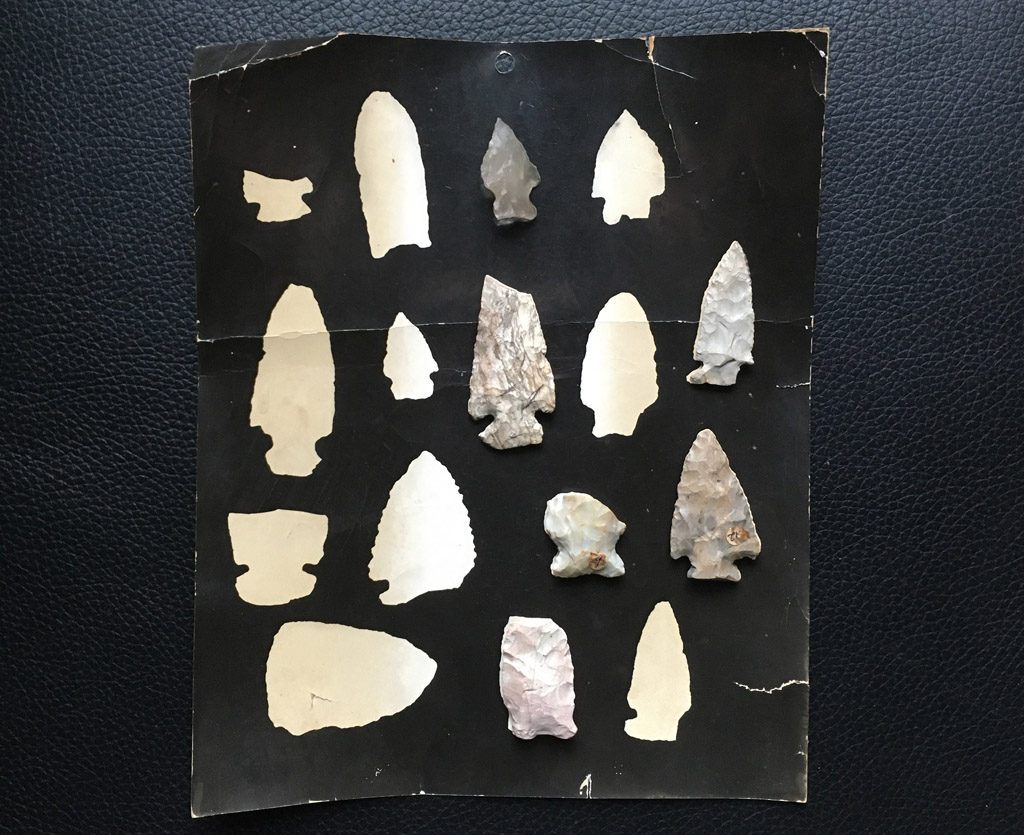Variations on a theme of Thanksgiving, as related by the sandy loam.
…
Many of us choose to garden as a way of getting back to the earth. But in doing so, we sometimes encounter traces left by those who knew the earth, long ago.
When turning the soil, even amid thoughts of early peas, it is hard to resist the urge to wonder what else we are turning up. The soil is a grand and pervasive sink, patiently and persistently collecting an imperfect but enduring record of the presence of past generations, and yielding it back to whoever cares to see.
In my own garden, when I scan the surface of a freshly tilled plot after a hard rain, the traces I find hint of spearpoints, axe heads and hide-scrapers. Here, the top ten inches of soil has collected the record of perhaps ten thousand years of hunting and gathering that happened to cross this spot, now thoroughly disorganized by only a few generations of the farmer’s plow. When one spall is found near another, they are likely not telling the story of a single flint-knapping session, or even two from the same lifetime, but of a host of similar moments repeated across lifetimes that never could have intersected. Yet it is not only the plow that has made their history hard to grasp. When archaeologists recover stone tools from undisturbed plots of ground that are otherwise similar to this one, often the smallest differences among them are enough to prove that the sample spans thousands of years — evidence of the astonishing endurance of a technology that spun a common thread across hundreds of generations of human experience.

Lost and found
On the neighboring farm where I grew up, by the time I was born my grandparents, parents and older siblings had collected more than a dozen examples of the handiwork of these ancient artisans, in the form of projectile points, or arrowheads as we called them, that would occasionally surface in the back field. Like many farm families, we admired them with a naïve but reverent curiosity, borne of their sheer alienness to the way of life that we knew, and the mystical skills that we imagined must have been employed to make them.
Today, few would even know how to begin to make an equal product from a rock. Once when I was a young child, an older brother visited the Southwest and brought back for me a boxed collection of tourist-trade arrowheads he had bought from a souvenir stand (I’d made no secret of my disappointment at not having yet found a real one). But even to my young eyes they were disappointingly different; so sharp, smooth, and perfect they might have been shaped on a rotary grinding stone, as they likely were. I knew then that I hadn’t been walking the field to look for an arrowhead, exactly – but for a connection to a remote and mysterious past.
It is speculated that when an intact projectile point reveals itself today, it was once given up for lost when it either dropped from a careless hand or, more interestingly, missed its quarry and landed inconveniently elsewhere, perhaps lodged irretrievably in the trunk of a tree. There it patiently remained, even as the tree grew to maturity, died, and rotted back into the soil, often joining a sparse accumulation of others that completed this cycle a hundred or a thousand years before. Ultimately it is we who find them, lying at a loose end on the surface – ripped from their repose by the unlikely conspiracy of a steel plow and a spring rain, completely obsolete in the functional role for which they were so carefully crafted, continuously, by a long chain of successive generations.
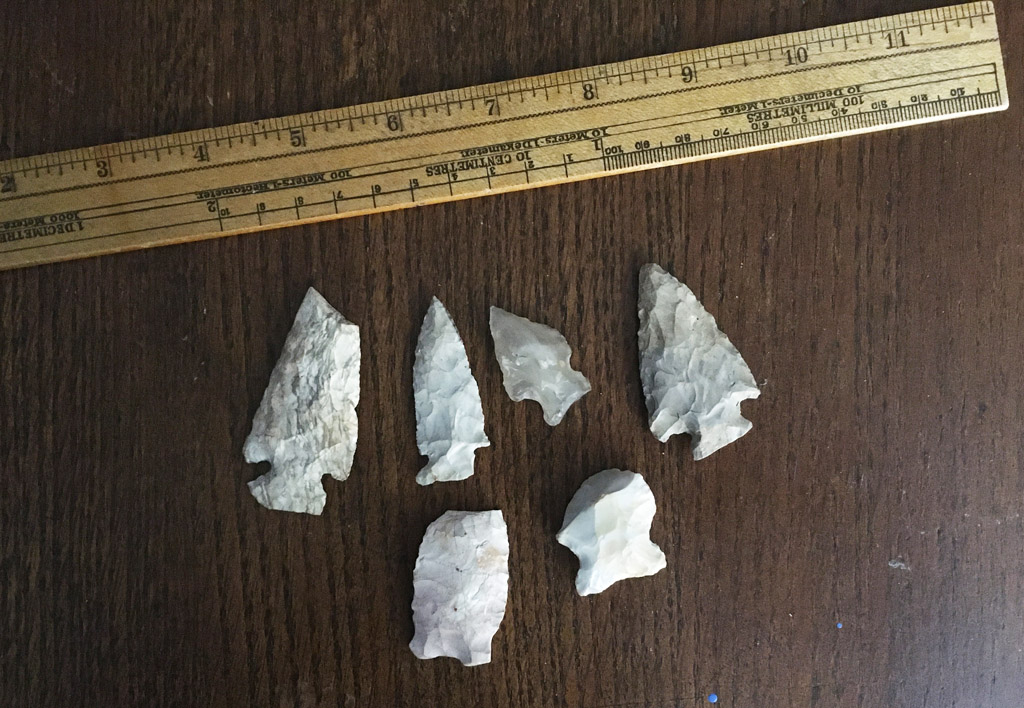
Echoes
The indigenous peoples who left these traces in southeastern Michigan are imagined more as hunters than as farmers. But in the New England states, the colonizers’ concept of pre-Columbian culture included the concept of native agriculture as well. Schoolchildren are probably still told that in 1621, an Indian named Squanto approached the Pilgrims’ party at Plymouth and informed them, in English no less, that the crop they were planting would come to nothing unless they buried a herring in every hill of corn. Although this narrative distorts the nature of the event and the origin of the advice, the story has become one of the primary vectors by which today’s society credits the native American with an agricultural tradition.
Two centuries later, but not far away, Henry David Thoreau would plant a small field of corn and beans, and make a similar observation:
…in the course of the summer it appeared by the arrow-heads which I turned up in hoeing, that an extinct nation had anciently dwelt here and planted corn and beans ere white men came to clear the land, and so, to some extent, had exhausted the soil for this very crop.
Henry David Thoreau, “Walden”
Although the traces of native agriculture were not as persistent as their hunting implements, Thoreau knew that the data was biased in that way. Every culture pursues more than a single activity, and if the soil could portray the full facts, we might detect as much similarity across the ages, as we do difference.
I would be delighted to encounter even a fragment of an arrowhead someday in my garden, but such a feat is not as likely for me as it was for Thoreau, nor as likely as it was for my family. At twenty feet by seventy-five, my garden is only one-seventieth the size of his field, and twice again smaller than my family’s. I was just one of a family that encountered sixteen points or fragments in a field of five acres over the four decades that saw the family grow from three to seven. My fuzzy calculations suggest that, if an arrowhead even exists somewhere within the bounds of my garden, it would take more than a hundred springtimes for my lone pair of eyes to spot it.
The artifacts of our own culture have since given it ample competition. Bits of the cast-off articles of the more recent inhabitants of this property have already accumulated among the potatoes and beets, in countless shards of crumbling plastic and corroded metal that surface with the stones. Trained for detection of triangles, notches, and serrations, my eye has yet to find the filter that will reject these spurious signals at the rate they would demand.
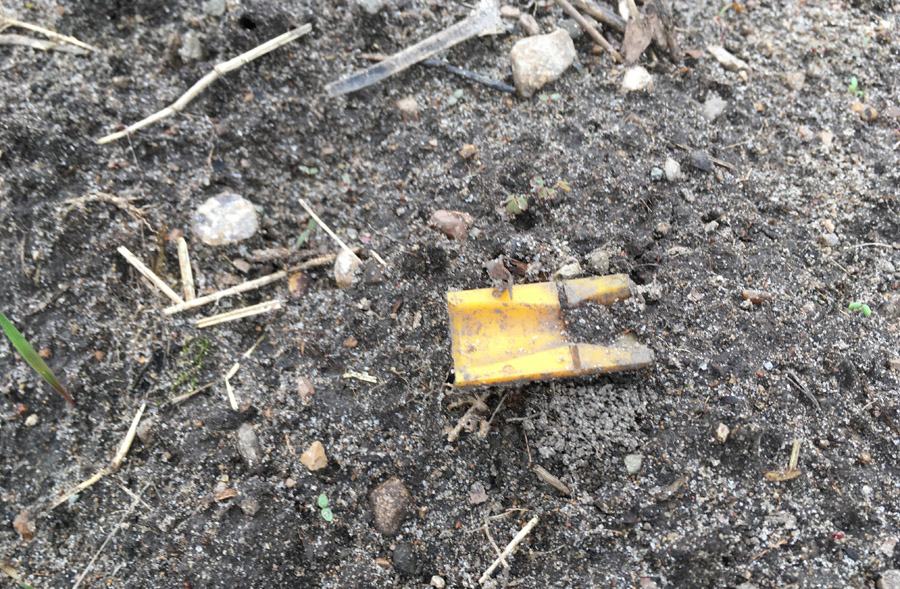
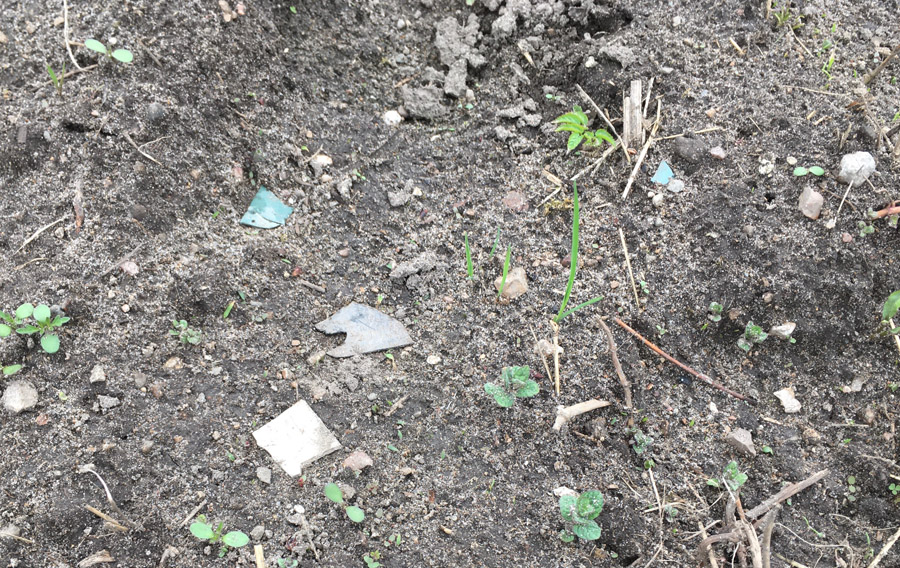
If I were to tire of scanning the ground, I could turn to the larger assemblies of steel and iron that linger in the forgotten places where they were last set aside, now sinking into the ground or embedded in the base of living trees that have sprung up since. Their original uses and applications, from a distance of only two or three generations, seem almost as remote as those of a stone tool.
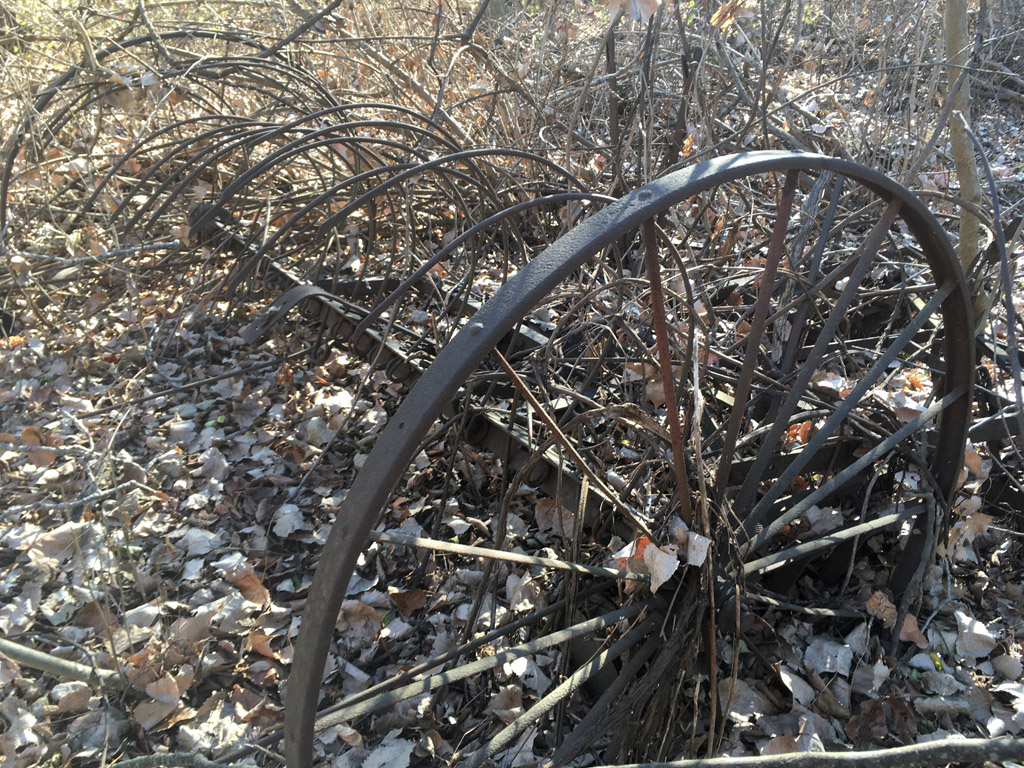
These leavings suggest a pace that has quickened substantially since the deepest layers of loam were first laid down here. While an ancient hunter might have delighted in hunting with the long-lost spearhead of an unmet ancestor, pulled from the soil or the bark of a tree, no one will be digging these scraps out of these trees. Where have their users gone, so soon? Like the patient arrowhead, these rusty lumps will someday be all that remains of their woody host, rejected by the indifferent biome like an indigestible pit, unlikely to arouse even reverent curiosity in those who might someday find them.

Going home again
Early historians found it convenient to portray Squanto’s assistance as an affirmation of the colonists’ presence. But the story more closely resembles a desperate search for community in the wake of personal tragedy. Schoolteachers rarely cite the primary sources, which reveal that ‘Squanto’ was actually Tisquantum, a Patuxet who had been kidnapped and enslaved in Europe a decade before, where he gained some command of the English language before scratching his way back to America — only to find that his entire village had been wiped out by European diseases years before. He came upon the Plymouth colony only because it had been opportunistically built on the abandoned site of that village.
While we cannot presume to know Tisquantum’s true motivations, it seems that, having set out for home and finding it to be lost, his attachment to its soil was strong enough to overcome the irony of serving a people who he must have known were at the root of his hardship.
People often remain drawn to their birthplace, as if they see its soil in everything that springs from or stands upon it. The fact that I unintentionally came to reside so close to my own has something to say about this. When circumstance drove me back to a place I had only known as a child, my preference would have been to remain thousands of miles from here, where I had been gladly conducted by the nomadic bent of modern society. But it is something more than a consolation that I can now hear the same train whistle that punctuated the nights of my infancy; breathe the same scents that drifted in through the open summer windows; and with every barking dog in the night, recall my young mind’s imaginings of the mysterious, unseen interactions that availed the cover of darkness in the shadowy fields and woods. Unsought, but now appreciated, these insubstantial echoes form a shimmering portal to my childhood, one that I can embrace or dismiss at will, and they identify this place on earth as much as the stones that silently lie beneath it.
One day long ago, my father decided to document the sixteen points and fragments that we had found, by placing them on a sheet of photographic paper and exposing it. For years it hung on the wall of my childhood home, in a room that we called the den, where all the cool and interesting things that a poor family might have managed to acquire were kept, like the short wave radio and the small aquarium, and a melange of meticulously painted models of monsters and muscle cars.
One of the points was made of a white translucent stone, resembling quartz. Placed top and center on the sheet, he must have anticipated that it would make a darker impression than the others.
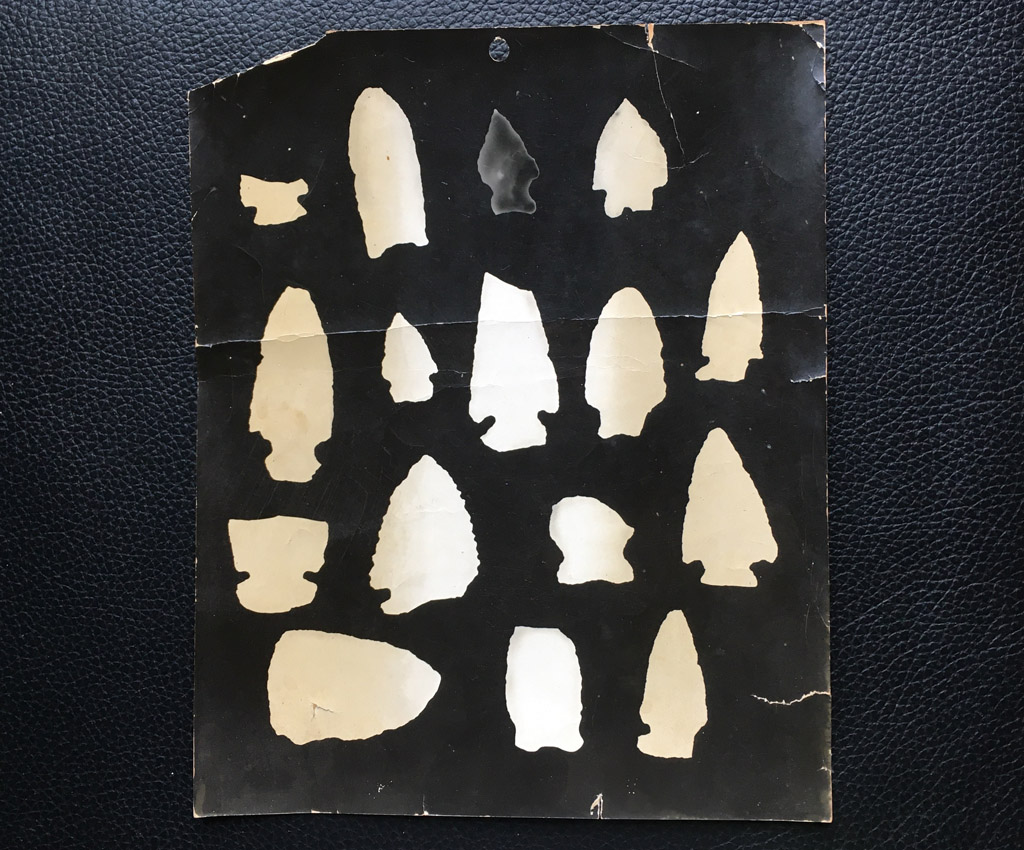
The sheet bears a single hole, made by a handheld paper-punch, by which my father hung it on the wall. Not a pinprick at every corner for a set of controlling, prescriptive thumbtacks, but a single punched hole, for a loose pin. As it hangs on the wall of my home, I can see the wisdom of this choice. As the weather changes, it curls or flattens, the photo emulsion holding tight as the paper backing swells or shrinks with humidity. Thus, as an object, this tattered sheet remains somewhat alive, imperceptibly animating the ghostly impressions of once-treasured tools that were lost, and then found again. Today, their yellowed white shadows, reassembling for a moment the lost items of widely scattered lifetimes, seem to embody the emptiness of time, and the inevitability of the loss of possession — of life, or love, or merely one’s grasp on a tooled stone — that haunts the human experience.
Indeed, many of these have been lost again. Only six have found their way to my possession, and largely by accident. They are the specimens found by a sibling, who in youth was much luckier than me, and at some point had apparently segregated them from the family collection, shortly before he unexpectedly died. Via his possessions, some of which I later inherited, they avoided whatever fate the others found, which are as lost to me as if they had been left in the bark of a tree.
Our understanding of the found artifacts of ancient peoples has gradually progressed from one of naïve curiosity to one that better appreciates the contexts that they communicate.
Even the assumption that Tisquantum was teaching an agricultural secret of his tribe is highly suspect. Given that he was brought back from Europe by the Newfoundland Company to work as a guide, it is more likely that he learned of fish fertilizer from the Company, whose rapacious fishing boats plying the virgin waters of Newfoundland produced an unmanageable surplus of fish:
…While he was working in Newfoundland, the Company had been overwhelmed by the abundance of fish to a point where they used them as fertilizer, so Squanto had learned the use of fish from colonists in Newfoundland and was merely passing on his new-found knowledge to the Pilgrims.
– Sanborn C. Brown, Wines & Beers of Old New England
Indeed, one would think that, in the subsistence culture of the native American, a fish in the hand would be worth at least as much as a speculative ear of corn in the fall [1]. The commercially extractive culture of the Europeans was much more likely to conceive of a rationale for viewing this valuable and preservable protein source as merely a fertilizer — and to then presume that the natives did the same.
Thus it is that the artifacts we find in the soil speak not only of bygone ways of life and past technologies, but also of the history and tradition they once embodied, and the tragedy that surrounded their decline. Judging from the abundance of modern debris scattered about and beneath the soil of this farm, our own way of life has already deposited its testimony, as if bound for a similar arc.
Technologies and the cultures they surround are destined to rise and fall. But in the fullness of time, all roads seem to circle back — to the things that are most fundamental, and ultimately, to the sifting of the earth.
. . .
I
Only a man harrowing clods
In a slow silent walk
With an old horse that stumbles and nods
Half asleep as they stalk.II
Only thin smoke without flame
From the heaps of couch-grass;
Yet this will go onward the same
Though Dynasties pass.III
— Thomas Hardy, ‘In Time of “The Breaking of Nations”‘
Yonder a maid and her wight
Come whispering by:
War’s annals will cloud into night
Ere their story die.
[1] Ceci, Lynn. “Fish Fertilizer: A Native North American Practice?” Science, vol. 188, no. 4183, 1975, pp. 26–30. JSTOR, http://www.jstor.org/stable/1740002. Accessed 11 Aug 2022.
Article and photos Copyright 2022 by the author.
